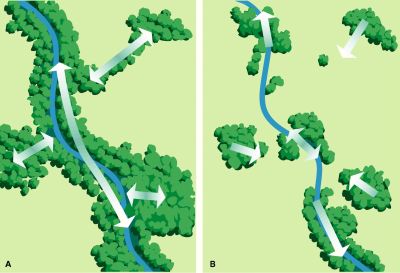In brief
Vermont’s wildlife requires food, water, shelter and mates to survive and reproduce. Different species travel various distances to meet these basic needs. As they move from one large tract of habitat to another they need some sort of connection – or corridors. These corridors can be a narrow swath of wetland along a stream, a large swath of forest, or a tunnel under an interstate highway. Without these corridors, wildlife struggle to maintain healthy, genetically diverse populations.
The issue
Building homes, businesses, shops and services further from our historic centers on larger lots of land can take a toll on Vermont’s natural environment. These buildings, along with the roads and other infrastructure needed to service these developments, can carve up habitat that our wildlife needs to survive.

As land is converted for human activities, habitats that were once contiguous become divided into separate fragments. If populations of plant and animal species are not free to move from one area to another, population extinction or inbreeding may result. Providing linkages between habitats reduces these risks and helps maintain genetic diversity and a population’s health. Conservation of large tracts of habitat linked via corridors are both necessary to maintain our wildlife habitat and natural areas.
According to the Vermont Department of Fish and Wildlife, corridor habitat is important as it:
- Allows animals to move freely across their range;
- Allows plants and animals to colonize new habitat as climate change, succession, or other ecological processes force them to migrate;
- Reduces the risk of population isolation and provides for the exchange of genetic information among populations of animals and plants;
- Allows animals to access suitable habitat to meet their daily and annual life needs;
- Allows seasonal movements (migrations) to essential range or habitat;
- Allows young adult animals to access new range, away from their natal range; and
- Allows adult animals to interact with potential mates, thus improving reproductive success and genetic fitness.
Communities in Vermont can work with the Vermont Agency of Natural Resources to determine where large habitat areas and key corridors are located in their town and work to implement tools that will these corridors. They can also work with their Conservation Commission and/or local land trust to ensure key wildlife corridors remain open for the movement of plant and animal populations.
Related Issues
Related Tools
Related Case Studies
Resources
Vermont Fish and Wildlife Department has a community wildlife program that can help communities understand how local resources, including wildlife corridors, connect to the larger landscape.




